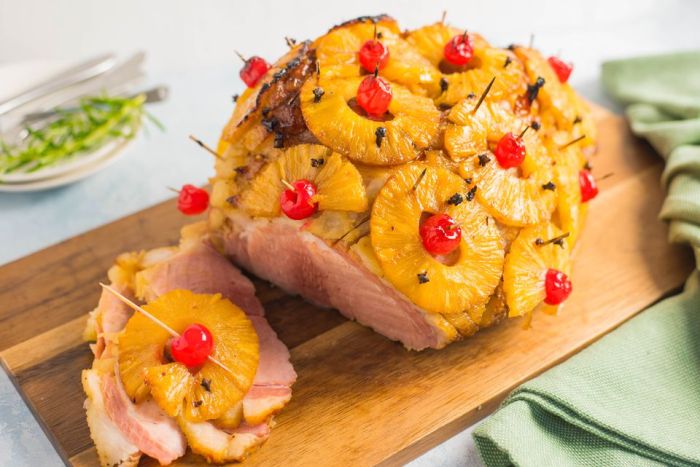Tips for Cooking Ham with Pineapple
How to cook ham with pineapple filipino style – When cooking ham with pineapple Filipino style, it’s important to choose the right type of ham. Opt for a fully-cooked ham that is boneless for easier preparation. Make sure to glaze the ham with a sweet pineapple sauce to enhance the flavors. Additionally, marinating the ham in pineapple juice and spices overnight can help infuse the meat with delicious tropical flavors.
What You Mean by Cooking Ham with Pineapple Filipino Style

Cooking ham with pineapple Filipino style refers to the traditional way of preparing ham in the Philippines, which involves using sweet and tangy pineapple flavors to enhance the taste of the meat. This method typically involves glazing the ham with a pineapple sauce and serving it with pineapple slices for added sweetness.
What is Known about Cooking Ham with Pineapple Filipino Style
Cooking ham with pineapple Filipino style is a popular dish in the Philippines, especially during holidays and special occasions. The combination of sweet pineapple and savory ham creates a delicious and festive flavor profile that is loved by many. This dish is often served with rice or potatoes as a main course.
Solution for Cooking Ham with Pineapple Filipino Style
To cook ham with pineapple Filipino style, start by preparing the glaze using pineapple juice, brown sugar, and spices. Score the ham and brush it with the glaze before baking it in the oven. Serve the ham with pineapple slices and additional glaze for a delicious and festive meal that is sure to impress your guests.
Are you ready to learn how to cook Chicago style ribeye like a pro? Look no further, as we have the perfect guide for you! Check out this step-by-step tutorial on how to cook Chicago style ribeye and impress your friends and family with your culinary skills. From selecting the best cut of meat to mastering the perfect sear, this guide has got you covered.
Get ready to elevate your steak game to a whole new level!
Detailed Information on Cooking Ham with Pineapple Filipino Style
When cooking ham with pineapple Filipino style, it’s important to choose a high-quality ham that is fully cooked and boneless. Make sure to remove any skin or excess fat before glazing the ham with the pineapple sauce. You can also add cloves, cinnamon, or other spices to the glaze for extra flavor.
Are you ready to learn how to cook Chicago style ribeye? This mouthwatering recipe will have you sizzling with excitement as you sear the perfectly marbled steak to juicy perfection. Follow this step-by-step guide on how to cook Chicago style ribeye and impress your family and friends with a delicious steak dinner!
Marinating the ham in pineapple juice and spices overnight can help tenderize the meat and infuse it with tropical flavors. Make sure to baste the ham with the glaze every 30 minutes while baking to ensure that it stays moist and flavorful. Serve the ham with rice or potatoes and garnish with fresh pineapple slices for a beautiful presentation.
Conclusion
Cooking ham with pineapple Filipino style is a delicious and festive dish that is perfect for holidays and special occasions. By following these tips and guidelines, you can create a mouthwatering meal that is sure to impress your family and friends. Enjoy the sweet and savory flavors of this traditional Filipino dish and savor every bite!
FAQs: How To Cook Ham With Pineapple Filipino Style

1. Can I use fresh pineapple for this recipe?
Yes, you can use fresh pineapple instead of canned pineapple for a more intense flavor.
2. How long should I bake the ham for?
Bake the ham for about 15 minutes per pound at 325 degrees Fahrenheit, or until it reaches an internal temperature of 140 degrees Fahrenheit.
3. Can I make this dish ahead of time?
Yes, you can prepare the ham and glaze ahead of time and bake it right before serving for convenience.
4. What other spices can I add to the glaze?
You can add cloves, cinnamon, nutmeg, or ginger to the glaze for additional flavor.
5. Can I use a different type of ham for this recipe?
You can use any type of fully-cooked ham for this recipe, but boneless ham is recommended for easier preparation.
